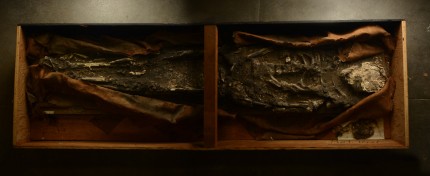The 6,500-year-old skeleton excavated from Ur in 1929 and rediscovered last month in the basement of the University of Pennsylvania’s Penn Museum is now on public view. It was moved from storage on Saturday to the museum’s In the Artifact Lab, glass-walled conservation lab that gives visitors the chance to see conservators at work. The focus is usually the conservation of mummies and artifacts from the museum’s Egyptian collection, but special projects from other departments also get a turn in the Artifacts Lab.
The Ur skeleton will be on partial view while on a working table inside the glass-enclosed lab space, with some images and information provided on a video screen. As soon as conservators complete their work documenting, cleaning, and stabilizing the skeleton, it will move to a display case in front of the lab; then visitors will have an opportunity to get a very up-close view.
Conservators estimate that the skeleton will be ready to move to the case by late September (date to be posted on the Museum website when known); the skeleton will stay on view through Saturday, October 18, when the Museum celebrates International Archaeology Day with a host of family activities and a chance to visit the new Center for the Analysis of Archaeological Materials.
Museum visitors will have the opportunity to ask questions of the researchers. Every day through September 14th, a physical anthropology expert will be available from 11:00 until noon and 1:00 to 2:00 PM to answer questions. From September 16th through October 18th, an expert will be available Tuesdays, Thursdays, Fridays, Saturdays and Sundays from 1:00 to 2:00 PM.
I love Penn Museum’s emphasis on giving their visitors immersive experiences (Touch Tours for the blind, 40 Winks with the Sphinx sleepovers for kids). The discovery of the Ur skeleton generated a lot of interest, so they set up a way for people to see him and learn more about him while conservators take care of business.
Speaking of learning more about the skeleton, Dr. William Hafford, Penn Museum’s Ur Digitization Project Manager who found the reference to the skeleton in the division lists of Sir Leonard Woolley’s Ur excavation, has written a fascinating blog entry about the history of the dig and the excavation of the skeleton. This is my favorite part:
[Woolley] covered the bones in wax, just as he had done with the later skulls in the Royal Cemetery, and almost certainly thought of this as a display item rather than a study item. That is probably why he sent it to Philadelphia. We didn’t have a Physical Anthropology Section at the time, but a representative sample of all Ur material was to be sent to each museum, and the human remains had mostly gone to London. […]
Nearly 85 years later, not only does Penn have an excellent Physical Anthropology Section, we also have new techniques for analyzing the fragile and wax-coated skeleton, such as CT scans, DNA testing, and isotope testing. By reconnecting a skeleton to its records, we have reestablished a key portion of the history of this person and he can now help us to learn about his culture in ways that his excavators never predicted.
